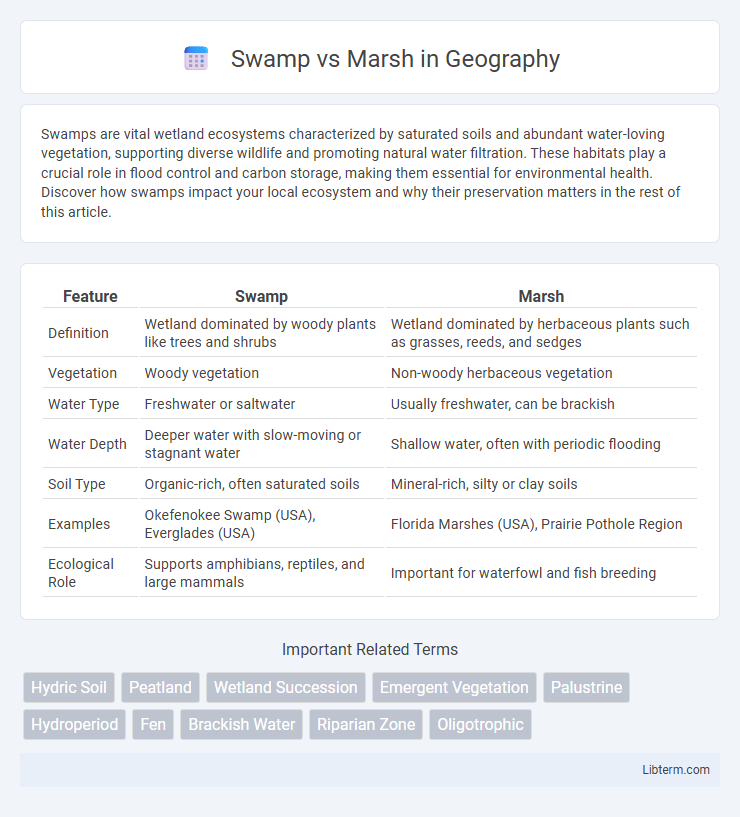Swamps are vital wetland ecosystems characterized by saturated soils and abundant water-loving vegetation, supporting diverse wildlife and promoting natural water filtration. These habitats play a crucial role in flood control and carbon storage, making them essential for environmental health. Discover how swamps impact your local ecosystem and why their preservation matters in the rest of this article.
Table of Comparison
| Feature | Swamp | Marsh |
|---|---|---|
| Definition | Wetland dominated by woody plants like trees and shrubs | Wetland dominated by herbaceous plants such as grasses, reeds, and sedges |
| Vegetation | Woody vegetation | Non-woody herbaceous vegetation |
| Water Type | Freshwater or saltwater | Usually freshwater, can be brackish |
| Water Depth | Deeper water with slow-moving or stagnant water | Shallow water, often with periodic flooding |
| Soil Type | Organic-rich, often saturated soils | Mineral-rich, silty or clay soils |
| Examples | Okefenokee Swamp (USA), Everglades (USA) | Florida Marshes (USA), Prairie Pothole Region |
| Ecological Role | Supports amphibians, reptiles, and large mammals | Important for waterfowl and fish breeding |
Introduction to Wetlands: Swamp vs Marsh
Swamps and marshes are two distinct types of wetlands characterized by their water sources and dominant vegetation. Swamps are forested wetlands with woody plants like trees and shrubs, often found in slow-moving rivers or floodplains. Marshes are wetlands dominated by herbaceous plants such as grasses, reeds, and sedges, typically located in shallow freshwater or saltwater environments.
Defining Swamps: Key Characteristics
Swamps are wetlands dominated by woody vegetation such as trees and shrubs, characterized by saturated soils and slow-moving or stagnant water. They often support diverse ecosystems with species adapted to waterlogged conditions, including cypress, mangroves, and tupelo trees. Unlike marshes, which are primarily herbaceous, swamps play a crucial role in water filtration, flood control, and carbon sequestration.
Understanding Marshes: Main Features
Marshes are wetlands dominated by herbaceous plants such as grasses, reeds, and sedges, typically found in areas with slow-moving or stagnant water. They play a crucial role in water filtration, flood control, and providing habitat for diverse wildlife, including amphibians, birds, and invertebrates. Unlike swamps, marshes usually have higher nutrient levels and less woody vegetation, making them essential for maintaining ecological balance and supporting biodiversity.
Types of Swamps and Their Ecosystems
Swamps are wetland ecosystems dominated by woody plants and are typically divided into forested swamps and shrub swamps, each supporting diverse flora such as cypress, mangroves, and willows. These swamps provide critical habitats for various wildlife species, including amphibians, birds, and mammals adapted to water-saturated soils and fluctuating water levels. The nutrient-rich water and soil in swamps contribute to high biodiversity and play a vital role in water purification and flood control within their ecosystems.
Varieties of Marshes and Their Habitats
Marshes consist of various types such as tidal, freshwater, and saltwater marshes, each supporting distinct ecosystems and species adapted to specific water salinity and flooding patterns. Freshwater marshes, often found inland, support cattails and reeds, while saltwater marshes along coastlines foster salt-tolerant plants like cordgrass. Tidal marshes experience regular flooding from ocean tides, creating dynamic habitats crucial for birds, fish, and invertebrates.
Vegetation Differences: Swamp vs Marsh
Swamps are dominated by woody plants such as trees and shrubs, providing dense canopy cover, while marshes primarily support herbaceous vegetation like grasses, reeds, and sedges. Swamps often contain hardwood trees like cypress and mangroves, adapted to saturated soils, whereas marsh vegetation thrives in nutrient-rich, shallow water environments with plants that tolerate frequent flooding. The difference in plant types influences the overall ecosystem structure, with swamps supporting more complex wildlife habitats due to the presence of woody vegetation.
Wildlife Diversity in Swamps and Marshes
Swamps support diverse wildlife, including amphibians, reptiles, and large mammals that thrive in forested wetland environments with abundant trees and standing water. Marshes provide habitats for numerous waterfowl, fish, and invertebrates due to their herbaceous plants and open, nutrient-rich waters. Both ecosystems play crucial roles in maintaining biodiversity by offering breeding, feeding, and sheltering grounds for various species.
Hydrology: Water Sources and Patterns
Swamps primarily receive water from slow-moving rivers, streams, or groundwater seepage, resulting in consistently saturated soils with standing water for most of the year. Marshes are fed mainly by surface water, such as rainfall and seasonal flooding, causing fluctuating water levels that dry out periodically. The hydrological patterns in swamps support water-tolerant woody plants, while marshes favor herbaceous vegetation adapted to more variable moisture conditions.
Ecological Importance and Environmental Roles
Swamps and marshes both serve critical ecological roles by providing habitat for diverse wildlife, supporting biodiversity, and acting as natural water filters that improve water quality. Swamps, dominated by trees and woody plants, contribute significantly to carbon sequestration and flood mitigation by slowing water flow. Marshes, characterized by herbaceous plants like grasses and reeds, are essential for nutrient cycling and serve as breeding grounds for many aquatic species.
Conservation Challenges and Protection Efforts
Swamps face conservation challenges due to altered hydrology and invasive species disrupting native ecosystems, while marshes struggle with pollution and habitat fragmentation impacting water quality and biodiversity. Protection efforts for swamps often involve restoring natural water flows and managing invasive plants, whereas marsh conservation emphasizes pollutant control and maintaining vegetation buffers. Both ecosystems require coordinated habitat restoration and monitoring programs to ensure the survival of distinctive wildlife and the preservation of critical ecological functions.
Swamp Infographic

 libterm.com
libterm.com